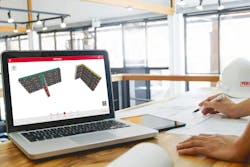From healthcare and food service to building and construction, the nationwide labor shortage is impacting every industry. Companies of all kinds are marshalling their resources to find enough employees with the right skill sets that will enable them to thrive as an organization.
The COVID-19 pandemic has served as a monumental disruptor, reshaping norms in the workforce:
- The construction industry lost one million workers during the initial COVID-19 pandemic shutdown and has yet to win back 1/5 of those workers. (Business Insider)
- Eighty-eight percent of contractors report moderate to high difficulty finding skilled workers. (US Chamber of Commerce)
- Forty-nine percent of civil contractors are putting higher bids on projects due to a shortage of skilled workers. (Civil Quarterly)
Add this to the ongoing monetary and time pressures on every construction job, and construction stakeholders of every kind must rely on technology innovations to go faster, maintain safety, minimize learning curves for the labor force and use solutions that reduce labor hours needed on site. This, in turn, drives costs down so they can remain competitive.
Riding the Technology Wave
In recent years, technology has taken the front seat on the construction site in a variety of ways. Equipment is GPS enabled. Site plans are on the cloud. Building models are digital 3D images. Tablets and cell phones have replaced paper drawings.
The shift to digital interactions is creating ripples across the construction industry – notorious for being hesitant to big change:
- Sixty-six percent of civil contractors say new technology has increased productivity. (Civil Quarterly)
- Forty-one percent of civil contractors say new technology has improved their ability to manage project budgets. (Civil Quarterly)
As younger workers enter the industry, there is an increased openness to apply new thinking and fulfill project needs with digital processes that expedite learning and building. These approaches also typically require fewer people, a solution needed at a time when finding, hiring, and training the right people is an uphill battle.
The new generation brings a different mindset to construction instruction and has a high capacity for adopting new technology and collaborating digitally. They enter the industry with a baseline knowledge of design software such as Building Information Modeling and an awareness of how to apply digital drawings to project sites.
A Framework for Smart Formwork
When the time comes to select equipment, contractors turn to companies they know that can deliver safe, cost-effective tools. With the labor shortage changing how projects can be staffed, the ability to use equipment that is safe, easy to learn, and fast to assemble is even more important.
For example, starting from the planning phase, using PERI QuickSolve allows construction professionals to digitally draw concrete wall layouts and divide concrete pours to match project cycling plans. The tool generates a formwork design around the wall layout along with a parts list and a 3D rendering, providing an optimal configuration proposal to purchase or rent PERI wall and slab formwork solutions.
Additionally, a customized digital planning tool to support the implementation of PERI UP, PERIpath is designed to enable the transparency of scaffolding activities and generates work packages based on a detailed scaffolding target estimate. It breaks down equipment needs, labor resources, scaffolding schedules, and costs to enable the careful management of costs by reducing equipment requirements, improving labor efficiency, and monitoring overall scaffold management.
With new technologies and software at their disposal, contractors who choose to engage a supplier early in the planning phase can better coordinate their work, and often complete projects sooner and with fewer on-site workers.
Modularized formwork and scaffold systems can be preassembled in a controlled environment and include access points and accessories, allowing crews to always work safely. By providing dedicated attachment points for safe use, crews no longer need to create access points while at height or spend time precariously accessing formwork.
Work of The Future
The Infrastructure Bill that became law this fall makes a substantial investment in improving roads and bridges across the nation. It also has the propensity to create two million new construction-related jobs per year over the next decade.
Translation: The labor crunch shows no signs of abating in the near term, which requires new thinking and approaches to hiring and working. That means construction professionals will need to look at ways to compensate for the new normal.
In this way, the drive to select innovative formwork and scaffolding solutions – ones that will save time and money – as well as technology for jobsites will play an even bigger role in the decision-making process as projects take shape.
Contact Information:
PERI Formwork Systems, Inc.
410.712.7225
[email protected]
https://www.peri-usa.com/


